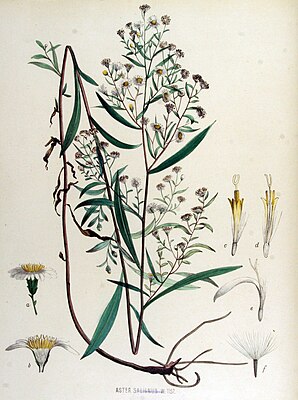Willow-leaved aster
| Willow-leaved aster | ||||||||||||
|---|---|---|---|---|---|---|---|---|---|---|---|---|

Willow-leaved aster ( Symphyotrichum salignum ) |
||||||||||||
| Systematics | ||||||||||||
|
||||||||||||
| Scientific name | ||||||||||||
| Symphyotrichum × salignum | ||||||||||||
| ( Willd. ) GLNesom |
The willow-leaved aster ( Symphyotrichum salignum ) is a hybrid between the two species New Belgian aster ( Symphyotrichum novi-belgii ) and lancet-leaved aster ( Symphyotrichum lanceolatum ) from the genus Symphyotrichum .
Another common German-language name for the area near Schulzendorf and Lüdersdorf in the Mark is the name Orant.
description
Basically, the willow-leaved aster has a strong similarity to the New Belgian aster , one of the two mother species, and can be distinguished from it, if at all, by smaller flowers , higher growth and narrow uppermost leaves .
Vegetative characteristics
Symphyotrichum salignum is a perennial herbaceous plant that reaches a height of 60 to 130 cm. The upright stem is angular, richly branched at the tip and short-haired . The stem leaves are lanceolate and alternate; the surface is also short-haired and rough.
Generative characteristics
The flower heads are 2 to 3 centimeters in diameter. While the tubular florets are yellow and small, the ray florets are light-whitish to red-blue in color. The bloom is coenokarp and consists of five stamens , a pen and two scars .
The number of chromosomes is 2n = 18.
ecology
The flowering period of the willow-leaved aster extends from August to October. Symphyotrichum salignum does not produce any fruit . She is a root creep pioneer.
Occurrence
The willow-leaved aster is a naturalized neophyte in Germany , both species originating from North America . As a wild ornamental plant , it has been at home in Central Europe since the 19th century at the latest and is now also found in Scandinavia, among others . In Central Europe it is a character species of the Senecion fluviatilis association, but also occurs in Convolvulion societies.
In Germany, the willow-leaved aster is not considered endangered and therefore does not receive any special legal protection .
Systematics
The first publication took place in 1803 under the name ( Basionym ) Aster × salignus by Carl Ludwig Willdenow . The new combination to Symphyotrichum salignum (Willd.) GLNesom was published in 1995 by Guy L. Nesom . Other synonyms for Symphyotrichum salignum (Willd.) GLNesom are Aster hungaricus Poir. , Aster salicifolius Scholler nom illeg. non lam. or Aster novi-belgii agg.
Individual evidence
- ^ Georg August Pritzel , Carl Jessen : The German folk names of plants. New contribution to the German linguistic treasure. Philipp Cohen, Hannover 1882, page 50, online.
- ↑ a b c Erich Oberdorfer : Plant-sociological excursion flora for Germany and neighboring areas . With the collaboration of Angelika Schwabe and Theo Müller. 8th, heavily revised and expanded edition. Eugen Ulmer, Stuttgart (Hohenheim) 2001, ISBN 3-8001-3131-5 , pp. 912 .
- ↑ Symphyotrichum salignum Willd., Weidenblatt-Herbstaster. In: FloraWeb.de. (accessed October 1, 2013)
- ↑ Willow-leaved aster . In: BiolFlor, the database of biological-ecological characteristics of the flora of Germany. (accessed October 1, 2013)
Web links
- Profile and distribution map for Bavaria . In: Botanical Information Hub of Bavaria .
- Aster x salignus Willd. In: Info Flora , the national data and information center for Swiss flora . Retrieved April 16, 2016.
- Thomas Meyer: Aster data sheet with identification key and photos at Flora-de: Flora von Deutschland (old name of the website: Flowers in Swabia ).
- Data sheet at NatureGate .